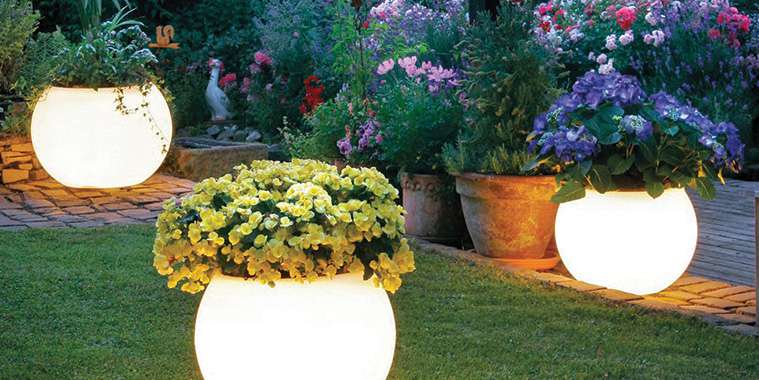By Dorothy Dobbie
There is something magical about lights in the garden. It’s a way of defying nature, of saying, “I don’t have to go inside. I can stay out as long as I like.” And today, there are just so many options from which to choose. You can go subtle or bold, bright or dim, ornate or simple. It’s another statement about you and your vision of the world.
Design
Garden lighting should be an extension of your garden design. It can enhance a plant or emphasize a seating area. It can create a warm glow or be a feature in itself. In small gardens, lighting can expand the space, whereas in large gardens, lighting serves to create new spaces. Think of the quality of the light when deciding what to do. Warm light makes things seem closer while white lights adds dimension, making things seem further away than they are.
Light up a fountain or a pool. String tiny lights through trees or along garden features such as fences. Light steps or stairs at foot level. Embed lights in the walkway. Highlight trees by up-lighting or down-lighting. Shine lights through a garden umbrella. There are endless possibilities beyond the obvious.
It used to be the fashion to up-light trees, and while this is still done, what about up-lighting a stand of Karl Foerster grass? A light fixture trained on a hanging basket can make that feature very prominent in the garden. And if you have a lot of lovely or interesting sculptures in the garden, use light to show them off at night. Many people light up their swimming pools or buy fountains with lighting as an integral part of the design. Use coloured lights with caution – too much or too many colours can end up looking gaudy unless you have a very sure eye.
Lighting systems
Today, you can choose from electrical or solar powered lights. Each has its advantages and isadvantages, however the electrical lights today are all low voltage so you will not break the bank on hydro bills. The advantage to electrical lighting is that you never have to worry about charging batteries and with the long life of LED systems, changing bulbs is a rare thing. Today’s energy-efficient LED lights use a lot less energy than traditional incandescent bulbs, last 25 times longer and have twice the lifespan of fluorescents. However, they cost more up front.
LED lights also change the quality of light. They send light in only one direction instead of scattering it. There are many sophisticated spot lighting systems available today with a capacity to do much more than the old scatted light systems. You can now get fixtures that will wash a wall with light or another that will direct the light to focus on a tree or fountain. There are ground light fixtures that will add a pop of light across a wide expanse, or walkway lights to illuminate steps or paths or even garden beds or send patterns of light across the face of your house or landscape.
The disadvantage of electrical lights are the requirement for wiring. Solar lights are inexpensive and versatile. Some can last for years, but some, . . .well, just don’t! The disadvantage of a solar system is unreliability if you live somewhere where it is often cloudy or very shady. Solar systems need ample sunlight to recharge batteries each day – basically the same number of hours of input as output. The advantage is that, with no wiring, you can place these lights wherever you like.
You can always use a mixture of electrical and solar lighting for maximum flexibility.
Other lighting ideas
A very effective but simple way to add light to a garden party is to put a lighting fixture under a table covered by a full length table cloth. The table will appear to glow in the night.
To light your garden party, candles are always a welcome choice (not under the table cloth!). The trick is to keep them from blowing out. Use a hurricane vase and set the candles inside. You can mute the light by covering the vase with tissue paper to create an ambient glow.
There are virtually hundreds of candle fixtures to choose from, many of them enclosed in glass to keep them burning throughout the evening hours.
Glass candle holders set adrift in the pool (weighted to keep them in place so they won’t all drift to the sides), are much more romantic than electric lighting. A similar approach can be used with bird baths and small water features.
Tiki torches are still popular, adding a special magic to an evening gathering (you can also get solar versions).
These are just a few ideas to get you thinking about lighting up your evenings in the garden. Light will keep you out there much longer and expand the garden enjoyment time during our short summers.
Dorothy Dobbie is the owner of Pegasus Publications, the publisher of Local Gardener & Manitoba Gardener.



